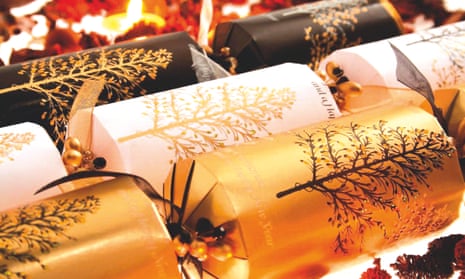What is the Queen going to find in her cracker tomorrow? Whatever it might be, it is certain the cracker itself arrived in a box labelled “Tom Smith”.
The original Tom Smith has good claim to be the inventor of the modern Christmas cracker. This week the V&A museum revealed what is inside an un-cracked 1927 Tom Smith with a design celebrating a musical called A Romance of the Canadian Rockies. The cracker was given to the museum by one of the musical’s chorus girls. An x-ray of the “totem” cracker shows that it still contains a chocolate.
This kind of showbusiness tie-in was typical in the heyday of the cracker. In the Edwardian period, the Tom Smith Company was producing more than 200 designs a year.
Born in 1823, Smith was a confectioner whose research into new product ideas turned up the Parisian practice of wrapping a sugared almond in a piece of paper twisted at each end, sometimes with a printed “love motto” included, too.
Smith went into business in the 1840s from his Finsbury premises, and consumers soon fell for his “ingenious” and “dainty” packaged almonds. You can spot a wrapped bonbon – just like Smith’s – hanging from Victoria and Albert’s Christmas tree at Windsor Castle, which was immortalised in an engraving for the special Christmas edition of the Illustrated London News in 1848.
This influential image of the royal couple and their children helped to popularise the German custom of a Christmas tree in Britain. But perhaps even more significantly, it spread the idea that Christmas was family time. People started to spend it at home in their own parlours, and to spend money on toys, gifts and decorations.
Smith made his big break in 1861 with a new product line called Bangs of Expectation. For the first time, these were recognisable crackers with a bang. You didn’t unwrap them; you pulled them.
Tradition has it that Smith invented the bang while staring one night into the fire, and being startled by the loud snapping sound of a log. But the research of Peter Kimpton, an expert on the history of crackers and a former employee of the Tom Smith Company, has discovered a more plausible chain of events. He cites the testimony of a rival businessman, Mr Brock of Brock’s Fireworks Manufactory in Nunhead, London. Brock claimed that Smith cannily bought the chemical recipe for the bang from Brock’s own pyro-technician, one Tom Brown.
Smith, then, was rather like his fellow Victorian entrepreneur Thomas Crapper. Many people think Crapper invented the flushing toilet, but really he was just a marketing genius who stamped his own name on the plumbing products he sold to the public. Smith, too, took care to promote his goods as the original and best: “See Tom Smith’s name on every box,” he advised his customers.
And with the bang, Smith perfected the idea that a cracker was entertainment. In this, he was building on a long history of festive parlour games.
Cracker contents became non-perishable, to allow for wider distribution. From the 1880s, Smith’s son introduced the paper crown, harking back to the ancient tradition of the Lord of Misrule, a person of low status who would preside over the Christmas festivities in a medieval household in an inversion of the normal social order. On Christmas Day, even the humble are crowned king.
The company’s buyers scoured trade fairs for cracker gifts that were often rich and rare: perhaps a little fan from Japan, or a knick-knack in Bohemian glass.
In many ways, these cracker gifts encapsulate the Victorian passion for junk. Living standards were rising and pockets were jingling; manufacturers had cracked the secret of making “must-have” things to sell to other middle-class Victorians.
The love motto in Tom Smith’s crackers also has its own history. Victorian families would have relished the reading out of a sentimental poem such as this 1875 offering: “Oh flowers, sweet flowers, the fairest gems that earth upon her bounteous bosom loves to cherish.” In true Victorian fashion, though, the poem ends with death: the flowers, “like morning dreams … quickly perish”.
The poems became rapidly less romantic in the 20th century. As the range expanded, you could buy more specialised crackers, like the Suffragette cracker of 1910. Its motto ran: “We want (as quickly as we can) / To have our say / Most likely ‘yes!’ / And to become ‘a match for man’”.
Then there were crackers aimed at that novel creature, the motorist: “And my poor heart, oh is it fair / To puncture it beyond repair?” The descent from romance towards the groan-making pun of today’s cracker had clearly begun.
And the answer to the mystery of what might be inside the Queen’s own cracker? The choice has often been surprisingly low-key. “No diamond brooches”, cracker historian Kimpton says, “more often things like key fobs.”
